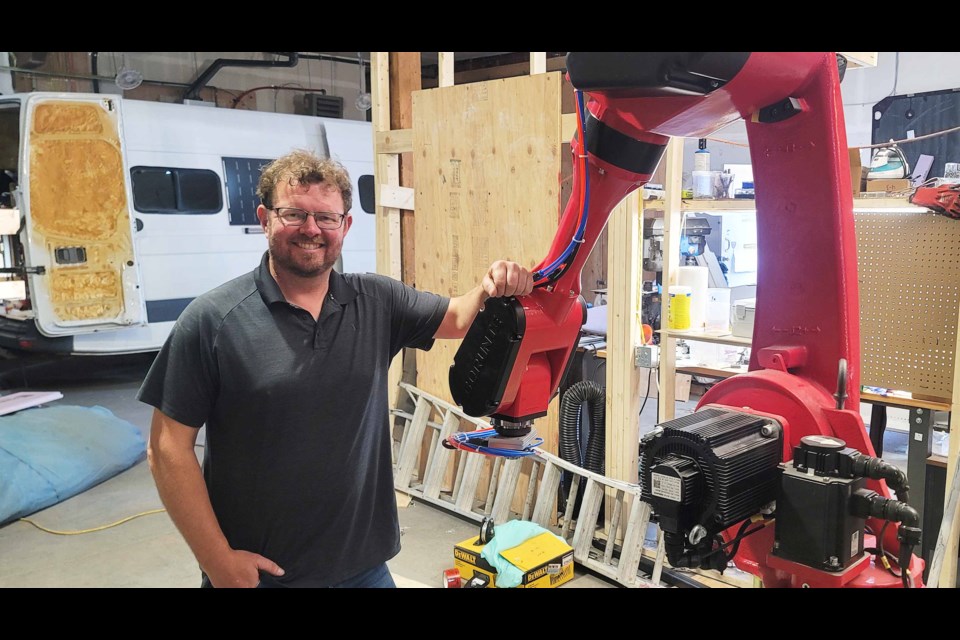Failure is the mother of invention.
For Prince George entrepreneur Simon Angus, mistakes made trying to build the world’s first fully sustainable electric-powered sailing catamaran became the blueprint for his latest innovation: virtually indestructible solar panels.
In November 2019, Angus quit his job as project manager at the Husky Energy oil refinery in Prince George (now Tidewater) and started Open Waters Design and Manufacturing. He spent the next two and a half years building a prototype for a lightweight carbon-fibre composite yacht that uses no fossil fuels and is compact enough to be shipped disassembled in a 40-foot rail car.
The catamaran relied on solar panels to power lights, refrigeration and other creature comforts, while the kinetic energy of the boat in motion turned propellers to store electricity through a hydro-regenerative system used to power twin 10-kilowatt electric motors.
The ship proved seaworthy in tests in Florida, but the project ultimately failed because the after-market solar panels cracked and didn’t generate enough electricity. Another issue was that the panels came only in rectangular shapes, limiting where they could be applied. That ruled out using solar in small or irregularly shaped areas.
“Those solar panels we bought — if you held them wrong, they would crack. And if you do that to all the panels, you end up with a very poor, inefficient solar array that isn’t going to generate the power you need,” said Angus.
Angus has since developed a way to produce panels with solar cells built into the laminate, which can then be cut into virtually any size or shape. The vacuum process starts with layers of composite fibre and solar cells laid over a recycled foam core material. Air is then sucked out between the layers to form ultra-tight bonds as they cure in a mould. Once cured, the panels are injected with resin to give them strength.
Just three millimetres thick, the finished panel is incredibly strong and durable, and can be used on boat decks or other surfaces.
“I said to myself, if we can encapsulate solar panels into a fibreglass laminate, then maybe we can protect the cells really well and do any sort of shape—and that’s what we’ve done,” said Angus.
“It’s got a non-slip coating on it, so when you glue this down to the boat you can walk on it. So basically it becomes a decking material, and we can do any size, any shape. You can take one of these panels and beat it with a stick and it basically won’t break. We’ve figured out how to make solar part of the boat.”
Word is getting out internationally to boat manufacturers looking for robust panels that offer a clean-energy alternative to noisy generators. The panels can also be used on building facades and other construction applications.
“We spent two years in (research and development) to try to figure out how to build it, and now we have so many orders that we’re automating the manufacturing process,” Angus said.
“It’s an expensive process right now. We can compete with diesel fuel, but we can’t compete with electricity, and we need to reduce the manufacturing costs.”
With Canada committed to increasing military spending — driven by Prime Minister Mark Carney’s pledge to allocate up to five per cent of the country’s GDP to defence by 2035 — Angus hopes to position his fibreglass panels for military use.
“There are military applications,” he said. “We’ve actually got people here with guns and we’ll shoot some of them to prove how durable they are. Obviously, you’ll blow a hole in it, but the idea is we don’t get short circuits and we don’t destroy them. We’ve already drilled holes in them and it hasn’t affected performance too much.”
Later this fall, Angus plans to install the panels on the exterior walls and roof of a 53-foot refrigerated trailer, typically used to haul perishables over long distances. The panels will be connected to a series of 60 kilowatt-hour lithium-ion batteries hooked to a phase inverter to maximize efficiency.
Once the trailer conversion is complete, Angus will have it towed to Golden, BC, where it will pair with a diesel-electric hybrid logging truck built by Edison Motors to demonstrate that green transportation is possible.
“We’re going to be able to charge the truck and do 100 kilometres on the charge,” said Angus. “We can really only afford to do those trailers when we’re fully automated.”
The current 6,000-square-foot shop will eventually produce panels with a daily electrical output of 12 kilowatts. Angus is also planning a 20,000-square-foot automated production facility that would boost output to 50 kW per day.
Open Waters, with a team of seven employees based in downtown Prince George, already has enough orders to stay busy through the summer. The company plans to expand its workforce to 18 by fall.
The Open Waters project is one of 12 selected as semi-finalists in the Northern Angel Summit. Angus is competing for a $100,000 prize, raised privately by 20 local investors in the Northern Innovation Network (formerly Hubspace). Six finalists will be chosen later this summer to pitch their projects Sept. 25 in a Dragon’s Den-style event at the Prince George Civic and Conference Centre.
The Northern Innovation Network provides business coaching, mentorship, training, networking and access to potential funding. The Sept. 25 event is sponsored by the Northern Development Initiative Trust, Innovate BC and Pacific Economic Development Canada.
Angus has already secured about $1.5 million in non-dilutive funding and loans, but says he needs to raise at least another $1 million in capital to unlock all available grant programs. He’s already received grants from the National Research Council, the BC Manufacturing Jobs Fund and BC Clean.
He hasn’t scrapped his boat-building ambitions, either. Angus still plans to give the sailing catamaran another go, this time using double the number of solar panels over the same space to generate more power.



.png;w=120;h=80;mode=crop)